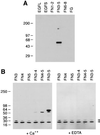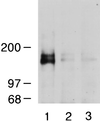The C-type lectin domains of lecticans, a family of aggregating chondroitin sulfate proteoglycans, bind tenascin-R by protein-protein interactions independent of carbohydrate moiety
- PMID: 9294172
- PMCID: PMC23322
- DOI: 10.1073/pnas.94.19.10116
The C-type lectin domains of lecticans, a family of aggregating chondroitin sulfate proteoglycans, bind tenascin-R by protein-protein interactions independent of carbohydrate moiety
Abstract
The lecticans are a family of chondroitin sulfate proteoglycans including aggrecan, versican, neurocan, and brevican. The C-terminal globular domains of lecticans are structurally related to selectins, consisting of a C-type lectin domain flanked by epidermal growth factor and complement regulatory protein domains. The C-type lectin domain of versican has been shown to bind tenascin-R, an extracellular matrix protein specifically expressed in the nervous system, and the interaction was presumed to be mediated by a carbohydrate-protein interaction. In this paper, we show that the C-type lectin domain of brevican, another lectican that is specifically expressed in the nervous system, also binds tenascin-R. Surprisingly, this interaction is mediated by a protein-protein interaction through the fibronectin type III domains 3-5 of tenascin-R, independent of any carbohydrates or sulfated amino acids. The lectin domains of versican and other lecticans also bind the same domain of tenascin-R by protein-protein interactions. Surface plasmon resonance analysis revealed that brevican lectin has at least a 10-fold higher affinity than the other lectican lectins. Tenascin-R is coprecipitated with brevican from adult rat brain extracts, suggesting that tenascin-R and brevican form complexes in vivo. These results demonstrate that the C-type lectin domain can interact with fibronectin type III domains through protein-protein interactions, and suggest that brevican is a physiological tenascin-R ligand in the adult brain.
Figures





References
-
- Ruoslahti E. Glycobiology. 1996;6:489–492. - PubMed
-
- Doege K, Sasaki M, Horigan E, Hassell J R, Yamada Y. J Biol Chem. 1987;262:17757–17767. - PubMed
-
- Rauch U, Karthikeyan L, Maurel P, Margolis R U, Margolis R K. J Biol Chem. 1992;267:19536–19547. - PubMed
-
- Yamada H, Watanabe K, Shimonaka M, Yamaguchi Y. J Biol Chem. 1994;269:10119–10126. - PubMed
Publication types
MeSH terms
Substances
Grants and funding
LinkOut - more resources
Full Text Sources
Other Literature Sources
Molecular Biology Databases

